Buying orchid mantis
Orchid mantis are currently in high demand due to their popularity online. If you’re looking to buy one, we’ll give you some pointers on who has them for sale, and why they make such interesting looking pets.
Looks
The Orchid Mantis, or Hymenopus coronatus, is one of the most stunning insects on the planet. It’s famous ability to mimic an orchid, with deep pinks, purples and whites, it what has made the orchid mantis such a desirable species. The Hymenopus coronatus originates from Malaysia, however has slowly crept into captivity.
As described by their name, the Orchid Mantis look like… an orchid. With white/pink projections over their legs, neck, and abdomen, they can make a fantastic camouflage when placed on an orchid. Males are distinctively smaller than females, with a much thinner body and less bulbas abdomen.
Some orchid mantises are totally white, whilst some have the pink/purple colourings. The actual colour of the mantis is very dependant on the environmental conditions, such as diet, lighting, humidity and surrounding. In the wild, regardless of colour, the Hymenopus coronatus would typically be found on orchids, flowers and insect-attracting shrubs.
As adult, both species possess fully grown wings, and the male can fly very well. Females can reach up to 6cm, wild caught specimens usually being slightly longer. Males will reach a maximum of 3cm, and are mostly under half the length of the female! This is the easiest way of determining sex, but can also be done by using the usual method, 8 segments for the male, and 6 or 7 for the female.
Humidity and Temperature
If pairs are being grown on to breed, then it is essential to change the growth rates of each species. Males must be slowed down, as naturally, they grow a lot faster than females. To do this, you must keep at cooler temperatures, and feed less than females. Around 15-18c will be the best for males, which will keep their growth rate very slow, but give them enough heat to metabolise. Females can be kept from 30-55c, and this will be the maximum temperature to increase growth rate. Humidity is essential, as the Hymenopus comes from Malaysia, a naturally humid country. This can be done by simply spraying the enclosure once a day. Substrate, like soil, peat, coconut fibre or kitchen towel can be used to keep humidity levels high. This will also help overcome any problems with shedding.
Housing and Enclosure
Being a tropical species from Malaysia, in captivity you will need to replicate these conditions for the orchid mantis as closely as possible. Generally this means a fairly high humidity (around 60-70%), and relatively high temperatures between 25-35c. The ideal temperature is in the middle – around 28c. Nighttime temperatures can drop to around 18-20c.
Males typically mature faster than females, so keep males at a cooler temperature (around 20c) will slow their growth if you’re looking to achieve adult stages at a similar time.
Whilst high humidity is recommended for larger nymphs and adults, the nymphs will be better suited to lower humidities – death in young orchid mantis nymphs can often be as a result of over spraying. As a result you should spray the enclosure just once every 5-7 days.
Enclosures should be well ventilated to allow a good flow of air, and to allow stagnant air to dissipate. As with most mantis enclosures, it’s recommended to have at least 1 mesh or net side on your orchid mantis enclosure – this is usually done with either the top of the enclosure or a mesh/net door on the front. Either way is fine (or any way), just as long as there is ample ventilation, and not a sealed unit.
In terms of height and width, the enclosure should be at least 3 times the length of the mantis in height to ensure ample room for skin shedding, and at least 2 times the length in width. The addition of extra branches and artificial flowers makes for a much more attractive enclosure.
Orchid mantis diet
Hymenopus coronatus feed primarily on flying insects in their nature habitat, which is why they are usually found on flowers. This would normally consist of pollen feeding flying insects (bees, wasps, moths, butterflies, etc), however this can be difficult to achieve in captivity.
Bluebottles and greenbottles can be the easiest food types (you can buy maggots from tackle shops and hatch them out, allowing the flies to feed on a honey mixture to gut load them slightly). But any other flying insects found outside or inside would be gladly received by the orchid mantis.
Young nymphs will happily feed on fruit flies, but larger pray will need to be introduced after L3/4 stage.
If flying pray isn’t achievable, then you can feed on crickets or locusts – but this is not recommended as a staple.
There have been many accounts of live food eating the mantis, so any food which has not been consumed within a day or so, should be removed.
Breeding Orchid Mantis
As mentioned above, the growth of the males and females will be very different, with males growing at a much faster rate. Therefore if you want to successfully mate your orchid mantis pairs, you will need to keep the males at a much lower temperature, and try to slow down the feeding cycles so the females are eating more.
Around 3 weeks after the final moult into adult, you can then introduce your male to the female. As a much larger, more aggressive specimen, the female orchid mantis should be well fed, and ideally eating at the time the male is introduced.
Orchid mantis ootheca will vary hugely in size, but you can expect to hatch up to about 90 young, all of which will emerge as jet black and red, skittish nymphs. Even from young nymphs, Orchid mantis are very ferocious when feeding, and will happily eat prey the same size – or bigger – when offered.
Once he has picked up her pheromones, he should make an advance and attempt to start mating.
Orchid mantis ootheca & nymphs for sale
I’ve currently got some sub adult and L6 females in stock, so will be looking to source some males soon. I should have excess ootheca and nymphs of my orchid mantis stock within the next few months. At the moment, the only ootheca I can source are wild caught. Please let me know if you’re interested by contacting me using the contact link at the top.
July 17 update: One of my adult females orchid mantis has laid her first ootheca:
Links
Here are a few useful resources to other websites on the Orchid mantis:
Orchid mantis evolution
Orchid mantis photos
Video of an Orchid mantis
I’ve also embedded a video below of a short orchid mantis documentary which was shown a few years back in the states, but gives a nice insight into natural habitat, colouration, camouflage, feeding, etc:
Orchid mantis (Hymenopus coronatus) Gallery
Please note the photos below have been collected from the web for reference, and each image links back to it’s original source. I don’t claim any copyright over these, and if you’ve got an image here that you’re not comfortable with and would like to be removed, then please get in touch.
Rate the orchid mantis
Do you keep this beautiful species, or did you have a great experience when you bought one from Insectstore? Please leave your rating below and tell us a bit about your experience with the Orchid mantis!



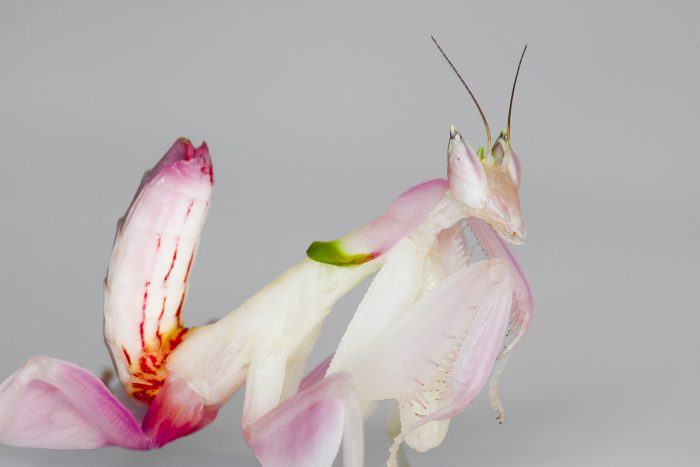

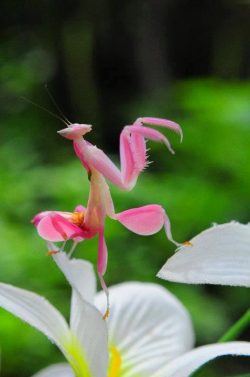
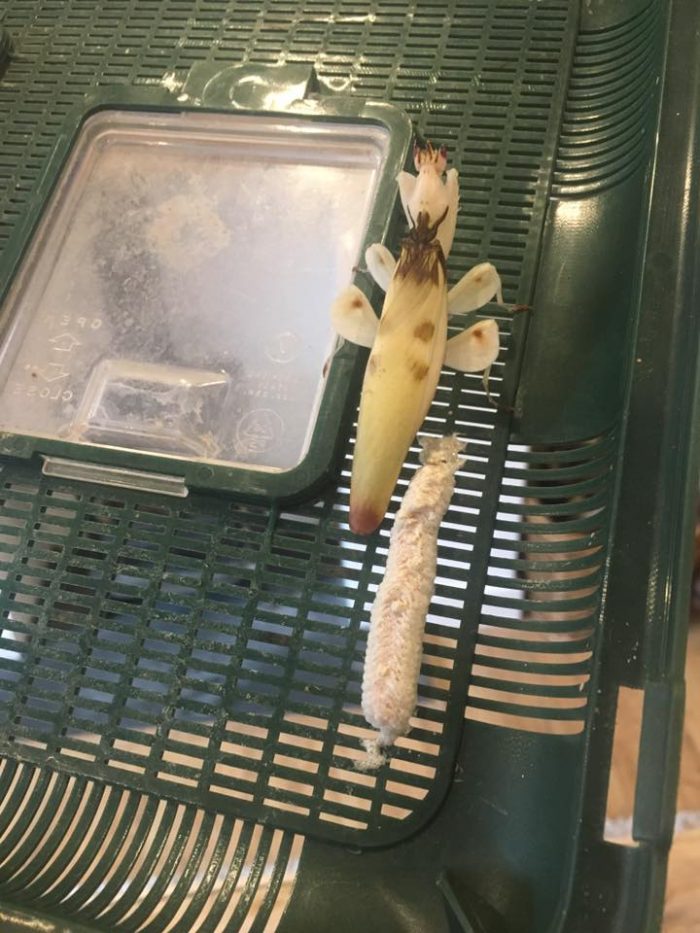
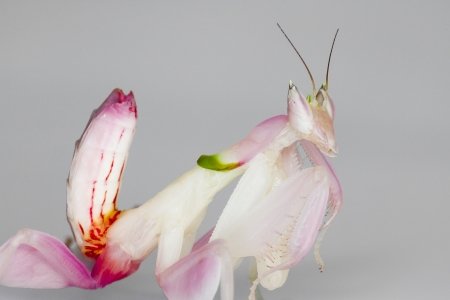
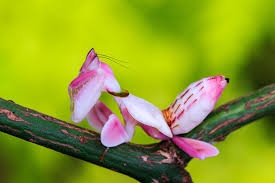
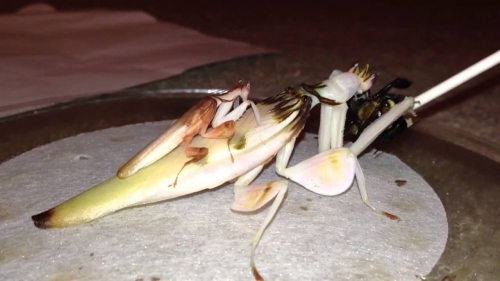
Orchid Mantis (Hymenopus coronatus) for sale – Buy orchid mantis nymphs & ootheca discussion:
Feel free to post any comments on this species below:
How much for orchid mantis egg cases
Hello, I don’t have any orchid mantis ootheca available at the moment, but if you drop me an email using the contact link at the top of the website, I’ll let you know when they come available. Thanks.
Looking to buy orchid mantis cases in springtime
I want a few male and female of this type
Where in ireland can I buy an Orchid mantis ?
Hi Jeff – unfortunately I am only familiar with UK and European breeders, have you considered importing one?
I own a birds of prey and reptile centre in northumberland. At present I am trying to acquire any adult mantis. I have an upcoming macro photography event and am wondering what species you have available and can they be delivered. Thankyou juanita.
Hi Juanita, if you drop me an email via the contact form at the top of the website, I can let you know what species are available.
Hello i’m interested in buying one of these mantids if possible
Where can i buy an Orchid mantis?
Where can i buy mantis oothecas in uk please as would love orchid mantis
Where could I buy Orchid Mantis Ootheca’s in the USA?
Where would I purchase these in the United states? Located in Washington state.
Hi Chandra – There are a few suppliers who currently have Orchid mantis in the Washington area – I’ll drop you an email.
Thank you so much! They are such beautiful insects. I love our native species but these guys have really caught my eye 🙂
I would also be interested in orchid mantis nymphs or an otheca. I’m in Tennessee but I would be willing to pay shipping!
I have a few people interested in buying Orchid mantises! I’m in Florida but will pay for express shipping from anywhere in the US
Where in USA and near California can I but some of these?
anybody got any oothecas for sale?
Looking for Orchids any stage any amount at least 2 needed in PA United States.
I tried using the in site support but no one emailed me back, looking for these or others in Alaska, can’t seem to find anyone that will ship, summer is here and it’s warm so shipping shouldn’t be an issue. They will live indoors.
Hello, i would like to buy an orchid mantid ootheca. Do you currently have any or know where to get them?
Is there anywhere in Canada where I can have some shipped (to Ontario)
Did you ever find anyone? Im in ontario and looking for one too.
Do you know anyone in Florida USA that would have orchids mantis for sale? I would think they would thrive here.
Thank You,
Any male orchid mantis for sale?
Hello Please let me know when you have some Orchid Mantid ootheca for sale I’ll buy a a few from you.
Also if you have any individuals for sale, perhaps a sexed pair, I may also be interested in buying.
Thank you.
Hi, I’m from the Philippines. Where can i buy a male and female orchid mantis ? I had one but it died last month due to old age. It was given to me as a gift by a friend who lives in Malaysia. Thanks and let me know. I am willing to buy from you and have it shipped to me.
Looking for either ootheca or nymphs, california.
Hello! I am looking for 1 or 2 orchid mantis!! 🙂
where can I buy cheap orchid prey mantids. pls help, I’ve been on the web for hours
Hi do you currently have male and female orchid matasis?
You said in july your female orchid had laid ootheca, any further update? 🙂 I’m interested in buying maybe an L3 or L4 maybe in a few weeks time.
Could you please tell me where I could buy a orchid mantis in the US?
I would like to buy orchid mantis please
Where could I buy these pls
Do you have any orchid mantis ootheca for sale? And can you ship to CA?
And if you have adult, what are your prices?
Hi, may I know the current status of orchid mantis? Also, I would like to know your shipping policy, thx!
Hello! I’m very interested in purchasing a few orchid mantises as nymphs or older for breeding my own! Please let me know when you have some available!
Do you have any orchid mantis for sale? I am looking for one and live in Vancouver BC Canada.
Kind Regards,
Marie
Sir/Madame, I have the experience of hatched three praying mantis cootheca in the season. I would like to enjoy the orchid praying mantid experience in New York if possible. Thanks so much for your great help! Peter Tsun
Hello. I am very interested in starting my own mantis collection. I love in CALIFORNIA and I’m not sure if you can ship here. I was hoping to start with an Orchid Mantis Ootheca. Any help or digestion you can give would be very much appreciated!
Thank you in advance
55 C is 131 F. In what world can any insect thrive at 131 F? Because of this I can not trust anything further on this page.
My orchid male just passed away and I am in Missouri in the United States. Does anybody have any they are willing to sell?
Hi do you have any availability soon x
Hello I’m interested in purchasing an orchid mantis!
Hello ! I was wondering if there was any Orchid Praying mantis for sale . I don’t mind what gender , I just wondered if you knew any in Atlanta / Georgia. I would love to have one please send me a note on my email if you find one.
Hi! I’m very interested in purchasing an orchid mantis! When can I buy one and can you ship them ?
Thanks Dinah
I am SO INTERESTED IN IN SEARCH FOR A orchid mantis! Please let me know when you have one! Thanks so much!
Alexis Medvik 586-222-4002
Where can I buy a baby female mantis in Edinburgh or around here
Hello I was just wondering if any orchid mantis are in stock and if there are any in Australia or people who ship to Australia
Where can i get one of these in the next month or so?
Hi, I live in Florida, and I’m interested in buying the orchid mantis! Do you know of any breeders in the area or if you have any in stock?
do you ship to the uk
can you tell me the prices and how many
I would love a oothecas
Hi I live in Hayward ca and I’m looking to buy and orchid praying mantis where can I buy one
Please contact me to buy the orchid Mantis please